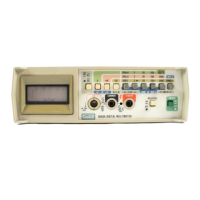4-26.
Cleaning
CAUTION
Do
not
use
aromatic
hydrocarbons
or
chlorinated
solvents
for
cleaning.
These
solutions wlll
react with the
plastic materials
used
In
the
Instrument.
CAUTION
Do not
allow
the LCD to come
In
contact with
moisture. Remove the LCD from the
Display
PCB Assembly
before
cleaning
the pcb, and
do
not
Install
the
LCD
until
the
pcb
Is
completely dry.
4-27.
Clean the front panel and case with a mild solution
of detergent and water. Apply the solution with a soft
cloth. Do not apply the solution directly to the front
panel. Clean dust and debris from the pcb's with low-
pressure
(20
psi) dry air. Clean contaminates from the
pcb's with isopropyl alcohol and a soft brush. Rinse with
demineralized water while scrubbing with a soft brush. To
dry the pcb's, remove any ICs in sockets and use low-
pressure dry air, then bake
at
50
to
60°C
(124
to
140°F)
for
24
hours. Replace any components removed for
cleaning and reassemble the instrument.
4-28. PERFORMANCE
TESTS
4-29.
The performance tests are used to compare the
8050A performance with the list
of
specifications given in
Section
I.
We
recommended
that
you
run
the
performance tests for incoming inspection and periodic
calibration.
If
the instrument fails any of the performance
tests, then calibration adjustment
and/
or
repair
is
needed.
4-30. lnltlal
Procedures
4-31.
Before begining each of the tests, perform the
following:
1.
Remove all test leads.
2.
Check the fuses and, if necessary, replace.
3.
Set
the
POWER
switch to
ON,
and allow the
8050A
to stabilize for approximately
5
minutes.
Conduct the tests in an environment with an
ambient temperature of
23
±
5°
C
(73
±
9°
F)
and a relative humidity of
less
than
80%.
4-32. Display Test
4-33.
Use the following procedure to verify the proper
operation
of
the LCD:
1.
Select
the
kO function,
2000
range.
MAINTENANCE
PERFORMANCE
TESTS
2.
Verify that the overrange indicator (
1)
is
displayed.
3.
Connect the red test lead to the
V/kO/S
input
connector
and
the black test lead
to
the
COMMON input connector.
4.
Refer to Table 4-3. Short
the test leads together
and verify that the display reads as shown for
each of the resistance ranges.
Table
4-3. Display Test
SELECT
RANGE
DISPLAY
20on
00.00*
2kS1
.0000*
20
kn
0.000
200 kQ
00.00
2000
kn
000.0
20MQ
0.000
*Due
to
test
lead
fesistance, the
least significant
digit(s) may fluctuate
by
several
counts.
5.
Select the
DC
V function, press the
REF
~
switch to the in position (on) and verify that
four decimal points appear on the display.
6.
Select
the
200V
de range.
7.
Connect the
DMM
Calibrator to the
8050A
as
follows: HI to the V /
kO/ S
input connector and
LO
to the
COMMON
input connector.
8.
Adjust the
DMM
Calibrator until the 8050A
displays
+
188.88V de exactly.
9.
Verify that all segments of the
8050A LCD are
illuminated and the
HV
annunciator appears in
the display.
10.
Set
the
DMM
Calibrator for
a-39V
de output.
11.
Verify that the HV annunciator disappears and
the polarity indicator changes to - (negative).
12.
Select
the dB function on the
8050A,
then set
the RELATIVE switch to
ON
(in).
13.
Verify that the dB and REL annunciators are
illuminated.
14.
This concludes the Display Test. Remove
power from the
DMM
Calibrator
before
dismantling the test setup.
4-5

